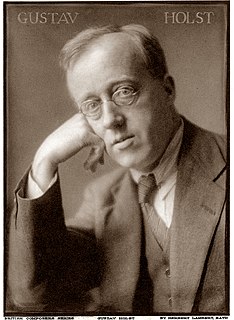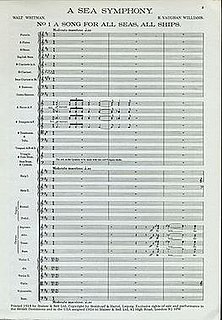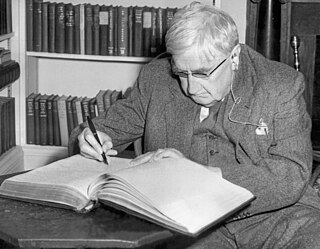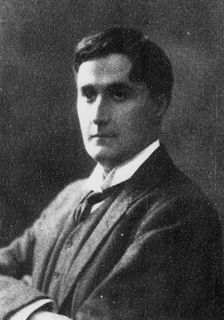
Gustav Theodore Holst was an English composer, arranger and teacher. Best known for his orchestral suite The Planets, he composed many other works across a range of genres, although none achieved comparable success. His distinctive compositional style was the product of many influences, Richard Wagner and Richard Strauss being most crucial early in his development. The subsequent inspiration of the English folksong revival of the early 20th century, and the example of such rising modern composers as Maurice Ravel, led Holst to develop and refine an individual style.

Ralph Vaughan Williams, was an English composer. His works include operas, ballets, chamber music, secular and religious vocal pieces and orchestral compositions including nine symphonies, written over sixty years. Strongly influenced by Tudor music and English folk-song, his output marked a decisive break in British music from its German-dominated style of the 19th century.

Herbert Norman Howells was an English composer, organist, and teacher, most famous for his large output of Anglican church music.
Symphony No. 5 in D major by the English composer Ralph Vaughan Williams was written between 1938 and 1943. In style it represents a shift away from the violent dissonance of his Fourth Symphony, and a return to the gentler style of the earlier Pastoral Symphony.

Fantasia on a Theme by Thomas Tallis, also known as the Tallis Fantasia, is a one-movement work for string orchestra by Ralph Vaughan Williams. The theme is by the 16th-century English composer Thomas Tallis. The Fantasia was first performed at Gloucester Cathedral as part of the 1910 Three Choirs Festival, and has entered the orchestral repertoire, with frequent concert performances and recordings by conductors and orchestras of various countries.

A Sea Symphony is an hour-long work for soprano, baritone, chorus and large orchestra written by Ralph Vaughan Williams between 1903 and 1909. The first and longest of his nine symphonies, it was first performed at the Leeds Festival in 1910 with the composer conducting, and its maturity belies the relatively young age — thirty — when he began sketching it. Moreover it is one of the first symphonies in which a chorus is used throughout as an integral part of the texture and it helped set the stage for a new era of symphonic and choral music in Britain during the first half of the 20th century. It was never numbered.

Crown Imperial is an orchestral march by William Walton, commissioned for the coronation of King George VI in Westminster Abbey in 1937. It is in the Pomp and Circumstance tradition, with a brisk opening contrasting with a broad middle section, leading to a resounding conclusion. The work has been heard at subsequent state occasions in the Abbey: the coronation of Queen Elizabeth II in 1953 and the wedding of Prince William in 2011. It has been recorded in its original orchestral form and in arrangements for organ, military band and brass band.

Ralph Vaughan Williams's Symphony No. 3, published as Pastoral Symphony and not numbered until later, was completed in 1922. Vaughan Williams's initial inspiration to write this symphony came during World War I after hearing a bugler practising and accidentally playing an interval of a seventh instead of an octave; this ultimately led to the trumpet cadenza in the second movement.
The Wasps is incidental music composed by the British composer Ralph Vaughan Williams in 1909. It was written for the Cambridge Greek Play production of Aristophanes' The Wasps at Trinity College, Cambridge, and was Vaughan Williams' first of only three forays into incidental music. A later performance of the work was one of only a small number of performances conducted by Vaughan Williams that was committed to a recording.

Ralph Vaughan Williams's Symphony No. 8 in D minor was composed between 1953 and 1955. Sir John Barbirolli, its dedicatee, conducted the Hallé Orchestra in the premiere at the Free Trade Hall in Manchester on 2 May 1956. It is the shortest of the composer's nine symphonies, and is mostly buoyant and optimistic in tone.

The Symphony No. 9 in E minor was the last symphony written by the English composer Ralph Vaughan Williams. He composed it during 1956 and 1957 and it was given its premiere performance in London by the Royal Philharmonic Orchestra conducted by Sir Malcolm Sargent on 2 April 1958, in the composer's eighty-sixth year. The work was received respectfully but, at first, without great enthusiasm. Its reputation has subsequently grown, and the symphony has entered the repertoire, in the concert hall and on record, with the majority of recordings from the 1990s and the 21st century.

Anthony Edward Payne was an English composer, music critic and musicologist. He is best known for his acclaimed completion of Edward Elgar's third symphony, which subsequently gained wide acceptance into Elgar's oeuvre. Apart from opera, his own works include representatives of most traditional genres, and although he made substantial contributions to orchestral and choral repertoire, he is particularly noted for his chamber music. Many of these chamber works were written for his wife, the soprano Jane Manning, and the new music ensemble Jane's Minstrels, which he founded with Manning in 1988. Initially an unrelenting proponent of modernist music, by the 1980s his compositions had embraced aspects of the late romanticism of England, described by his colleague Susan Bradshaw as "modernized nostalgia". His mature style is thus characterised by a highly individualised combination of modernism and English romanticism, as well as numerology, wide spaced harmonies, specific intervallic characterisations, and the frequent alternation between strict and fluid rhythmic frameworks.
The Concerto in A minor for Oboe and Strings was written by Ralph Vaughan Williams in 1943–44 for the oboist Léon Goossens, to whom the score is dedicated.

The Oxford Book of Carols is a collection of vocal scores of Christmas carols and carols of other seasons. It was first published in 1928 by Oxford University Press and was edited by Percy Dearmer, Martin Shaw and Ralph Vaughan Williams. It became a widely used source of carols among choirs and church congregations in Britain.

Sāvitri is a chamber opera in one act with music composed by Gustav Holst, his Opus 25, to his own libretto. The story is based on the episode of Savitri and Satyavan from the Mahābhārata, which was also included in Specimens of Old Indian Poetry and Idylls from the Sanskrit. The opera features three solo singers, a wordless female chorus, and a chamber orchestra of 12 musicians. Holst had made at least six earlier attempts at composing opera before arriving at Sāvitri.
A Cambridge Mass is a choral work in G major by Ralph Vaughan Williams written between 1898 and 1899 as part of his studies in Cambridge for his Doctorate of Music. It is one of two large scale choral works with orchestral accompaniment by Vaughan Williams surviving from this period, the other being a cantata setting of Swinburne's poem The Garden of Proserpine.

Byron Adams is an American composer, conductor, and musicologist.
Ralph Vaughan Williams composed his setting of the Magnificat or Song of Mary, one of the three New Testament canticles, in 1932. It is scored for contralto soloist, women's chorus, and an orchestra consisting of two flutes, two oboes, cor anglais, two clarinets, two bassoons, four horns, two trumpets, timpani, triangle, cymbals, bass drum, tambourine, Indian drum, glockenspiel, celesta, harp, organ, and strings.
This is a summary of 1907 in music in the United Kingdom.

The Lark Ascending is a short, single-movement work by the English composer Ralph Vaughan Williams, inspired by the 1881 poem of the same name by the English writer George Meredith. It was originally for violin and piano, completed in 1914, but not performed until 1920. The composer reworked it for solo violin and orchestra after the First World War. This version, in which the work is chiefly known, was first performed in 1921. It is subtitled "A Romance", a term that Vaughan Williams favoured for contemplative slow music.













